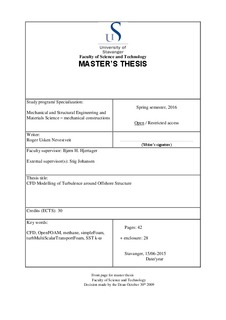| dc.description.abstract | Leakages of methane from the seabed is a common problem for oil companies, and they are held responsible for leakages surrounding the platforms at sea. These leakages has to be monitored in some way, and Stinger Technology has designed a construction for this purpose. The construction has different sensors mounted on it, two sonars detecting bubbles, one acoustic sensor monitoring flow direction and velocity, and concentration sensors, which measures the concentration of methane in the water.
The task here is to look at how the construction in itself affects the measurements done by the sensors. The first case is to look at the acoustic sensor, which monitors a user defined point in space above the construction. This point may very well be affected by the construction, causing wrong readings. The second task is to look at the concentration sensors located inside the construction. These readings may also be affected by the construction, and the amount of affection will probably vary depending on the flow direction, as the construction is not symmetric.
To know if the monitored regions are affected, equivalent monitoring points are setup in the simulations. The solver used in the simulations is the steady-state, incompressible solver simpleFoam, and the turbulence model is SST k-ω. For simulation of the methane in the water, a solver created by Knut Erik Giljarhus named turbMultiScalarTransportFoam has been used.
The results revealed that the point that the acoustic sensor now is monitoring, can be wrong with as much as up to 8% if the flow direction is directed so that the monitored point is downstream relative to the construction. This error can easily be reduced by moving the monitored point further away from the construction.
For the concentration measurements, most of the simulations did not show any affection from the construction at all, but if the flow comes in from the right angle, the concentration measurements showed a difference of up to 36,5% when comparing to the exact same simulation without the constructions presence.
The results seems to give logical answers, as the orientation of the flow was considered to give different results. | nb_NO |

